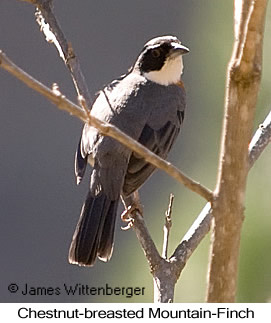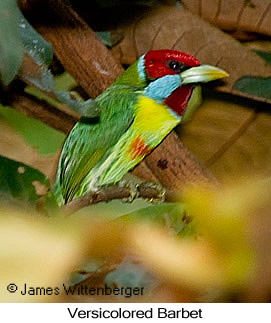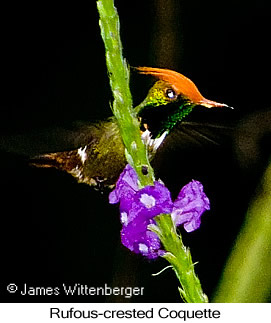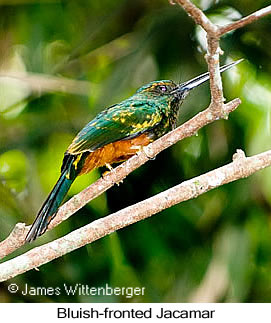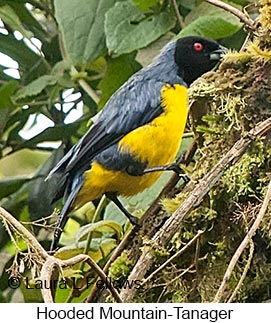HIGHLANDS/MACHU PICCHU/MANU ROAD TOUR
Tour Description

PERU
BIRDING TOUR
ANY TIME*
| Duration: | 13 days, 12 nights |
| Group Size: | 2-6 |
| Anytime Price: | $6600 |
| Group Price: | $6300 |
| Single Suppl: | $400 |
| Est #Species: | 450-500 |
| Pace: | Moderate |
| Difficulty: | Moderate |
| * This tour is available for any dates of your choosing provided guide services and accommodations are available. | |
DAY 1 - LIMA
Arrive at international airport in Lima and transfer to your nearby hotel. Night at Manhattan Inn Airport Hotel.
DAY 2 - VILLA MARSHES, PUCUSANA, CUSCO
Morning birding at Villa Marshes located 25 min south of Lima. It's the only preserved natural area around Lima, and the bulrushes and tall grasses are home to some interesting species including Wren-like Rushbird, Many-colored Rush Tyrant, and Yellow-hooded Blackbird. A number of open water species such as White-cheeked Pintail, White-tufted Grebe, and Great Grebe are normally present. Several coastal gulls are also there, notably Brown-hooded Gull, Belcher's Gull (Band-tailed Gull), and Kelp Gull. Also sometimes present, though often hard to find, is the endemic Peruvian Thick-knee. The nearby coastal beaches attract various terns and shorebirds. From there continue south another half hour to the coastal fishing village of Pucusana. Pucusana is a more reliable place for Peruvian Thick-knee and is also a great place to see the sought-after Inca Tern, the endemic Surf Cinclodes found on the rocky shoreline, and various arid scrub species such as Peruvian Sheartail, Long-tailed Mockingbird, Collared Warbling-Finch, Grassland Yellow-Finch, and Parrot-billed Seedeater. Afternoon flight to Cusco. Night at Hotel Casa del Rey Cusco.
DAY 3 - MOLLEPATA ROAD & SORAYPAMPA
All day birding high elevation site along Mollepata Road and nearby Soraypampa. Key species of interest in this new birding site are the endemic White-tufted Sunbeam, Vilcabamba Thistletail, Rusty-fronted Canastero, Creamy-crested Spinetail, Apurimac Spinetail, Chestnut Munia, Apurimac Brushfinch, and Chestnut-breasted Mountain-Finch. Night in Mollepata.
DAY 4 - CARRIZALES & ABRA MALAGA
Early start for Carrizales and Abra Malaga, the latter a high mountain pass reaching an altitude of over 14,000 ft above the pass. The Carrizales area is en route to the pass and offers good roadside birding just below tree line. Stunted cloud forest offers birds such as Unstreaked Tit-Tyrant, Brown-backed Chat-Tyrant, Red-crested Cotinga, Parodi's Hemispingus, Moustached Flowerpiercer, and Black-throated Flowerpiercer. Then return to the pass itself, where the habitat is open bush and Polylepis forest. An uphill walk of a few hundred meters through scrub and scrabble should produce the endangered Royal Cinclodes, an uncommon species amidst the more common Cream-winged Cinclodes (a recent split from Bar-winged Cinclodes) and the White-winged Cinclodes. Also usually present is Taczanowski's Ground-Tyrant among the rocks below the ridgeline. Continuing a short way farther up and then over the ridgeline leads to a trail into a patch of Polyepsis forest where one can typically find Blue-mantled Thornbill, Tawny Tit-Spinetail, White-browed Tit-Spinetail, Junin Canastero, Ash-breasted Tit-Tyrant, and Giant Conebill. Also possible is the secretive Puna Tapaculo. Checking the steep cliffs often reveals both Brown-bellied Swallow and Andean Swallow. And, it's always possible to detect an Andean Condor soaring overhead. Back at the pass other interesting species include Plumbeous Sierra-Finch, Ash-breasted Sierra-Finch, and sometimes Slaty Finch. Rarely, Gray-breasted Seedsnipe can be spotted along the road going back downslope. A short stop near Peñas is the best place to find White-tufted Sunbeam and sometimes also yields Swallow-tailed Hummingbird. Night at Ipal Eco-Lodge.
DAY 5 - CLOUD FOREST, CARRIZALES, & ABRA MALAGA
Morning birding cloud forest around the lodge looking for any species missed the prior day. Afternoon transfer to Ollantaytambo. Night at Ccapac Inka Ollanta Hotel
DAY 6 - MACHU PICCHU & CUSCO
Morning train to Aguas Calientes. Take bus up to Machu Picchu. Explore the ruins and look for a few interesting birds found in the scrub nearby and at the top of the trail leading back down the mountain, especially Inca Wren which is best seen there. Also possible are White-tailed Tyrannulet, Streak-necked Flycatcher, Blue-capped Tanager, Golden-naped Tanager, and Black-backed Grosbeak along with other species. Bird area outside Aguas Calientes as time permits. Late afternoon train to Cusco. Night at Hotel Casa del Rey Cusco.
DAY 7 - HUAYPO & HUACARPAY LAKES, MANU ROAD
Depart early for Huaypo Lake, a new destination for Andean lake species located 30-min from Cusco and from there continue to Huacarpay Lake. The lakes are at high elevation and surrounded by arid montane grassland and scrub. Possibilities on the lakes include Andean Goose, Yellow-billed Pintail, Puna Teal, Speckled Teal, White-tufted Grebe, and Andean Coot. Marshy shores are home to Plumbeous Rail, Wren-like Rushbird, Andean Negrito, Yellow-winged Blackbird and the beautiful but rare Many-colored Rush-Tyrant. A waterhole near Huacarpay Lake used by sheepherders usually attracts a nice variety of birds including White-browed Chat-Tyrant, Blue-and-yellow Tanager, Plumbeous Sierra-Finch, and Band-tailed Seedeater. Scrub habitat along the road around Huacarpay Lake is good for Rusty-fronted Canastero, Streak-fronted Thornbird, White-crested Elaenia, Chiguanco Thrush, Peruvian Sierra-Finch, Mourning Sierra-Finch, and White-winged Duica-Finch. It's also possible to find the spectacular Bearded Mountaineer, which feeds on the tubular yellow flowers of the wild Tree Tobacco growing in the outwash plains nearby. Flocks of Puna Ibis are usually present near the lakes or feeding in wet grassland along the upper Manu Road.
Continue downslope to San Pedro. Concentrate on mixed species flocks encountered along the way plus other interesting birds spotted along the way. The road passes through pristine forest as it descends to the middle elevation around San Pedro. Among the possibilities are Black-and-chestnut Eagle, Barred Forest-Falcon, Bar-bellied Woodpecker, Marcapata Spinetail, Plumbeous-crowned Tyrannulet, Bolivian Tyrannulet, Band-tailed Fruiteater, Three-striped Hemispingus, Orange-throated Tanager, Yellow-throated Tanager, Black-capped Tanager, Cuzco Brush-Finch, and Short-billed Chlorospingus. Sometimes seen along this stretch of road is the rare Greater Scythebill and the elusive Yungas Manakin. Sometimes a raucous flock of White-browed Jays makes an appearance. Crested Quetzal and Golden-headed Quetzal are possible as well. It seems every visit produces a surprising rarity. Arrive at the lodge late afternoon. Night at Cock-of-the-Rock Lodge.
DAY 8 - SAN PEDRO AREA
Cock-of-the-Rock Lodge is one of the original lodges along Manu Road. It's located on the San Pedro River and includes a private forested reserve with an extensive network of trails. All day will be devoted to birding the area. The forest trails are the best place to see Yungas Manakin. The secretive Brown Tinamou is possible as well. Other forest birds of special interest along the trails include Bluish-fronted Jacamar, Versicolored Barbet, Stripe-chested Antwren, Yellow-breasted Antwren, Slaty Gnateater, Cinnamon-faced Tyrannulet, Chestnut-breasted Wren, Black-eared Hemispingus, Plushcap, Rust-and-yellow Tanager, Orange-eared Tanager, and Black-faced Brush-Finch. Andean Cock-of-the-Rock will likely be seen along the trails or road. A nice variety of hummingbirds come to the feeders here and at Manu Paradise Lodge across the river. Some 13 species are possible including Green-fronted Lancebill, Blue-fronted Lancebill, Wire-crested Thorntail, Long-tailed Sylph, Booted Raquet-tail, Violet-fronted Brilliant, and Many-spotted Hummingbird. Optional night birding could produce Rufescent Screech-Owl, Rufous-banded Owl, Lyre-tailed Nightsjar, and Andean Potoo. Nights at Cock-of-the-Rock Lodge.
DAYS 9-10 - VILLA CARMEN BIOLOGICAL STATION
Two days birding mostly subtropical forest around Villa Carmen Biological Station and the lower section of Manu Road. Numerous species are possible in this bird-rich area. Possibilities include Sapphire Quail-Dove, Pale-winged Trumpeter, Yellow-billed Nunbird, Scarlet-hooded Barbet, Golden-collared Toucanet, Red-necked Woodpecker, Cream-colored Woodpecker, Dusky-billed Parrotlet,Rufous-backed Stipplethroat, Amazonian Antpitta, Marañon Spinetail, Hauxwell's Thrush, Creamy-bellied Thrush, Rufous-bellied Euphonia, Olive Oropendola, Red-capped Cardinal, Masked Crimson Tanager, Opal-rumped Tanager, Opal-crowned Tanager, and Guira Tanager, along with numerous hummingbirds, raptors, trogons, parakeets, macaws, antshrikes, antwrens, antbirds, woodcreepers, flycatchers, other tanagers, and much more. Nights at Villa Carmen Biological Station.
DAYS 11 - UPPER MANU ROAD & WAYQECHA
After early breakfast transfer to the highlands around Wayqecha at an elevation of around 10,000 ft. The habitat there is alpine woodland and scrub. Remainder of day and the following day birding above and below the lodge along the road. In the forested ravine and among stunted trees along the road possible birds include Gray-breasted Mountain-Toucan and mixed tanager flocks featuring Hooded Mountain-Tanager, Scarlet-bellied Mountain-Tanager, Buff-breasted Mountain-Tanager, Grass-green Tanager, and Golden-collared Tanager. Possibilities along the road in alpine scrub include Peruvian Piedtail, Rufous-capped Thornbill, Streak-throated Bush-Tyrant, d'Orbigny's Chat-Tyrant, Collared Jay, Blue-capped Tanager, Moustached Flowerpiercer, Deep-blue Flowerpiercer, and Black-faced Brush-Finch. After dark try for Swallow-tailed Nightsjar near the lodge. Night at Wayqecha Biological Station.
DAY 12 - UPPER MANU ROAD & CUSCO
Morning birding around the lodge. Transfer to Cusco, birding en route looking for Chestnut-breasted Mountain-Finch in the inter-montane valleys used by Qechuan peasant farmers to graze their animals and Creamy-crested Spinetail near the last Andean pass (Ajcanacu). A short side trip may produce Line-fronted Canastero and Scribble-fronted Canastero. If time permits try for Puna Tapaculo and Diademed Tapaculo in the same area. On clear days Andean Condor may be soaring overhead nearly anywhere above the high mountain valleys. Afternoon flight back to Lima. Tour ends at the airport in Lima.
DAY 13 - ARRIVAL HOME
Overnight flights reach North America and connecting flights early this morning (not included in tour price).
TOUR NOTES
Air fare within Peru included in the price.
ADDITIONAL INFO
(Not on Menu Above)
BIRDING LOCALES
